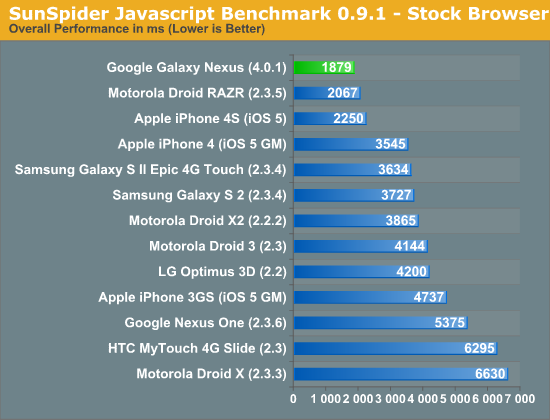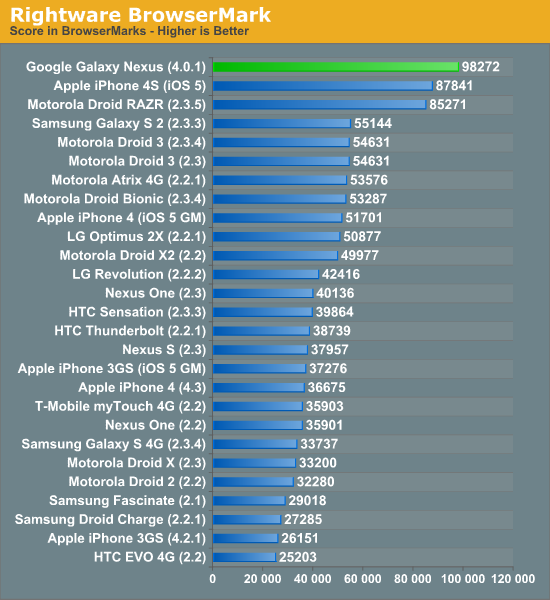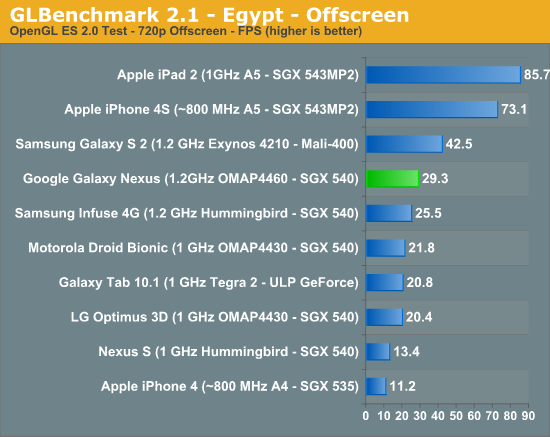Galaxy Nexus & Ice Cream Sandwich: Initial Performance Analysis
by Anand Lal Shimpi on November 18, 2011 11:42 PM ESTThe road to Google's Galaxy Nexus and Android 4.0 (Ice Cream Sandwich) is finally nearing its destination. As of yesterday, the Samsung made Galaxy Nexus went on sale in the UK. Its arrival in the US on Verizon is imminent, but it'll still be another couple of weeks before we can get our hands on a CDMA/LTE sample.
The Galaxy Nexus hardware platform isn't a significant departure from what we've already seen on Android. TI was chosen as the launch silicon partner with its OMAP 4460. The SoC takes a pair of Cortex A9 CPUs running at 1.2GHz and gives them a dual-channel LPDDR2 memory interface to talk to. The GPU is Imagination Technologies' PowerVR SGX 540. The CPU side of things is comparable to Apple's A5, although the cores are clocked noticeably higher than the 800MHz we saw in the iPhone 4S. Until Tegra 3 and Krait show up, the CPU side of the 4460 is as good as it gets.
The real advantage the Galaxy Nexus has is on the software side. All of the goodness of Honeycomb makes its way to a handset along with even further optimization work. One of the early Galaxy Nexus owners ran the usual browser benchmarks on his phone and shared the results with us. Google has obviously done a lot of browser optimization in ICS as performance is now better than even Honeycomb:


The GPU in the Galaxy Nexus isn't bad by any means - the SGX 540 is competent, but it is outgunned by ARM's Mali 400 (Samsung Exynos 4210) and the SGX 543MP2 (Apple A5). As I mentioned earlier, the Galaxy Nexus wasn't about putting the fastest hardware in a phone but rather providing a stable vehicle for Ice Cream Sandwich. Results for the Galaxy Nexus have been in the GLBenchmark database for a while and show an overall improvement over previous SGX 540 implementations (the GPU clock in the 4460 is higher than in the 4430):


Performance is pretty much as expected in both areas: Google really pushed the performance of its software further with Ice Cream Sandwich, while GPU performance is limited by the SGX 540. The good news is that there's more than enough hardware at ICS' disposal to deliver a smooth experience. We'll be able to quantify that once we get our hands on a device.
Source: GLBenchmark, @SigThief










69 Comments
View All Comments
jalexoid - Saturday, November 19, 2011 - link
Actually UI in ICS is H/W accelerated by default.eallan - Wednesday, November 23, 2011 - link
There is a whole lot of justification going around for picking a sub par GPU.The thing is, if they had included the 4S GPU or something more powerful, there wouldn't be a single complaint on any tech site.
They skimped, period. For cost savings or driver support, who knows. They did skimp though.
Exodite - Saturday, November 19, 2011 - link
Battery life is mostly dependent upon the usage scenarios. I get 7-10 days out of my Xperia arc but I reckon very few others can say the same.Point being that not many people actually need a powerful GPU in their smartphones, in which case the larger/more expensive chip makes little sense.
Of course it's a good idea to push for better performance on all levels but that's better off at 28nm, where a more advanced GPU wouldn't come at such a high price.
Personally I'd say the GPU is sufficient as soon as it can handle 1080p60 output and video decoding. But that's me, I still use my phone mostly as a phone.
piiman - Saturday, November 19, 2011 - link
"Battery life is mostly dependent upon the usage scenarios. I get 7-10 days out of my Xperia arc but I reckon very few others can say the same."Come on! Do you ever turn it on and use it?
Exodite - Saturday, November 19, 2011 - link
Oh it's always on, I'm just not a compulsive user.stm1185 - Saturday, November 19, 2011 - link
This argument is like backwards deja-vu. Except instead of the Apple product having the subpar graphics and fanboys defending that against PC users and their SLI'd super machines, its now Android fanboys defending it against the iPhone 4s and its over 200% faster GPU.Android phones need some Tegra 3 love already.
Exodite - Sunday, November 20, 2011 - link
Why does it always have to be defensive?Noone is questioning the fact that A5 has a significantly stronger GPU. It's just one of those components where the trade off in die real estate and cost doesn't necessarily make sense, certainly not for all users.
Everyone can immediately benefit from a stronger CPU, the same can't be said of an A5-class GPU.
Of course it would have been awesome with a stronger GPU as well but while the lack of such is s strike against the Galaxy Nexus it's a trivial concern compared to the lack of microSD-slot, for example. IMHO obviously, just pointing out that the GPU isn't a primary concern for /all/ users - as opposed to, say, the CPU or battery.
As for Tegra 3 it's unlikely it's going to be competing with the A5 either, at least as I understand it from what we know today.
jalexoid - Saturday, November 19, 2011 - link
iPhone4s has been plagued on battery ever since it launch, compared to iPhone4 or even SGS2.Tegeril - Sunday, November 20, 2011 - link
For certain users in specific circumstances, yes. I went 4->Nexus S->4S and the battery life for me is the same or better. The Nexus S I used in between was so sad in comparison.jalexoid - Saturday, November 19, 2011 - link
It's not a misstep. It's a baseline device. Every other manufacturer now has an idea how an average ICS phone should look like. Historically it's been the case with Nexus launches - it's the baseline for Android devices.Nexus One - baseline for 2010.
Nexus S - baseline for 2011.
Galaxy Nexus - baseline for 2012.